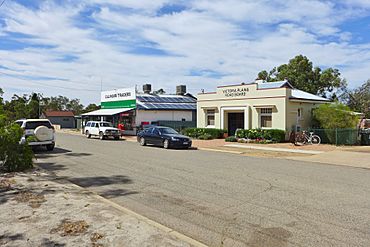Calingiri, Western Australia facts for kids
Quick facts for kids CalingiriWestern Australia |
|
|---|---|

Cavell Street, Calingiri, 2014
|
|
| Established | 1917 |
| Postcode(s) | 6569 |
| Elevation | 258 m (846 ft) |
| Area | [convert: needs a number] |
| Location |
|
| LGA(s) | Shire of Victoria Plains |
| State electorate(s) | Moore |
| Federal Division(s) | Durack |
Calingiri is a small town in Western Australia. It is located northeast of Perth, not far from New Norcia. The town is part of the Shire of Victoria Plains.
The name Calingiri comes from a nearby waterhole. A surveyor first recorded the name in 1903. The idea for a settlement here came up in 1914. By 1917, when Calingiri officially became a town, its name had been spelled many different ways. These included Calingtry, Kalingiri, and The Washpool, before it finally settled on Calingiri.
The main business in Calingiri is wheat farming. The town has a special site where farmers can deliver their grain. This site is run by the CBH Group, which helps store and move grain.
The Calingiri Earthquake of 1970
Calingiri experienced an earthquake in March 1970. At the time, it was one of only five known earthquakes in Australia that caused cracks to appear on the ground. These cracks are called surface faults.
Many people thought this earthquake might be connected to the 1968 Meckering earthquake. However, scientists could not directly link the two events.
Here are some facts about the Calingiri earthquake:
- Date: March 10, 1970
- Time: 3:15 AM local time
- Magnitude: 5.9 (This measures the earthquake's strength)
- Intensity: VI (Strong) (This describes how much shaking people felt and how much damage occurred)
Protecting the Environment
A large area of land around Calingiri is very important for birds. About 800 square kilometers (309 square miles) of land has been named an Important Bird Area. This means it is a special place where birds need protection.
This area is home to up to 20 breeding pairs of the Carnaby's Black-Cockatoo. These cockatoos are an endangered species, meaning they are at risk of disappearing forever. Protecting their habitat in Calingiri helps them survive.
One of the local nature reserves near Calingiri is named after Rica Erickson. She was a famous Australian botanist and historian.


